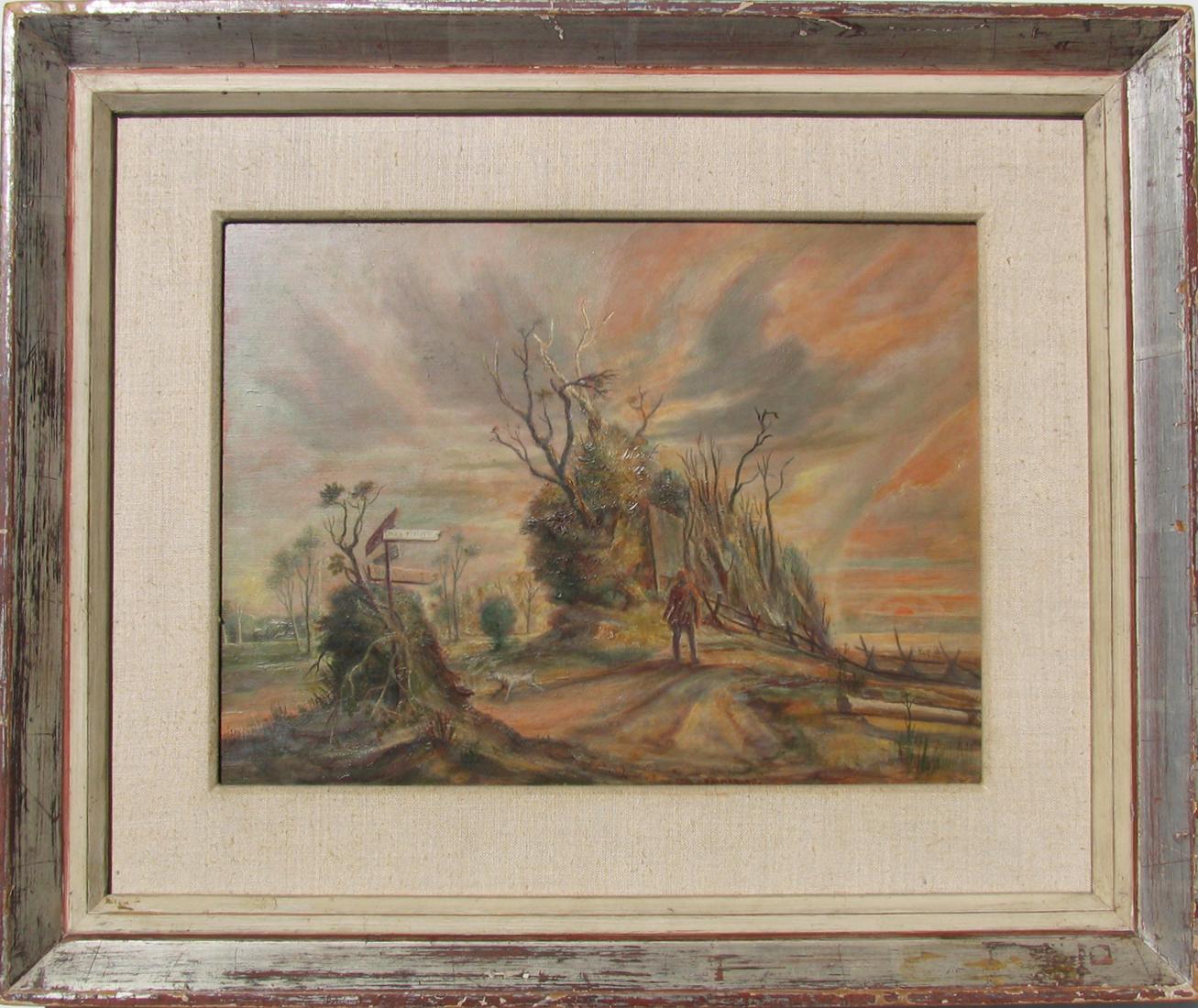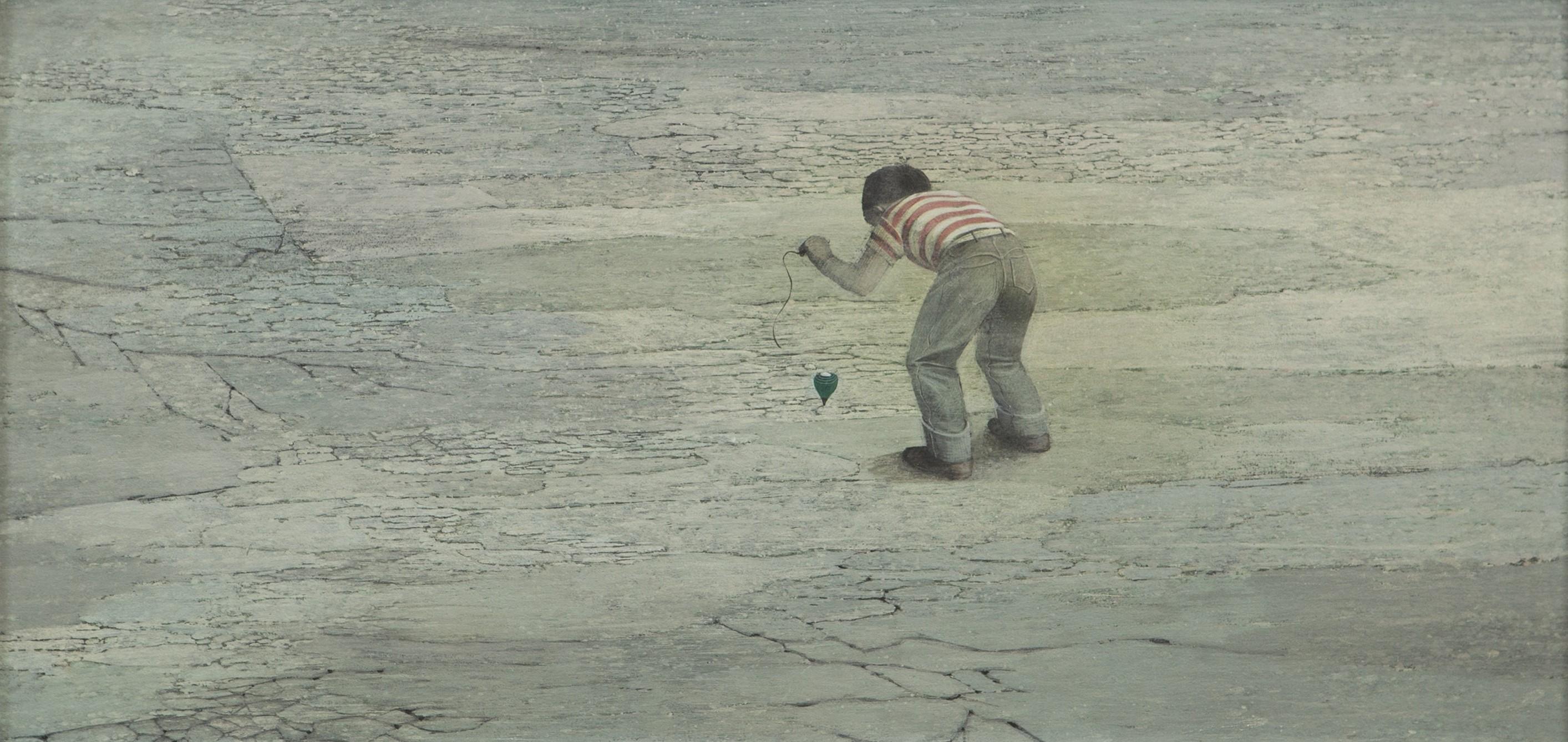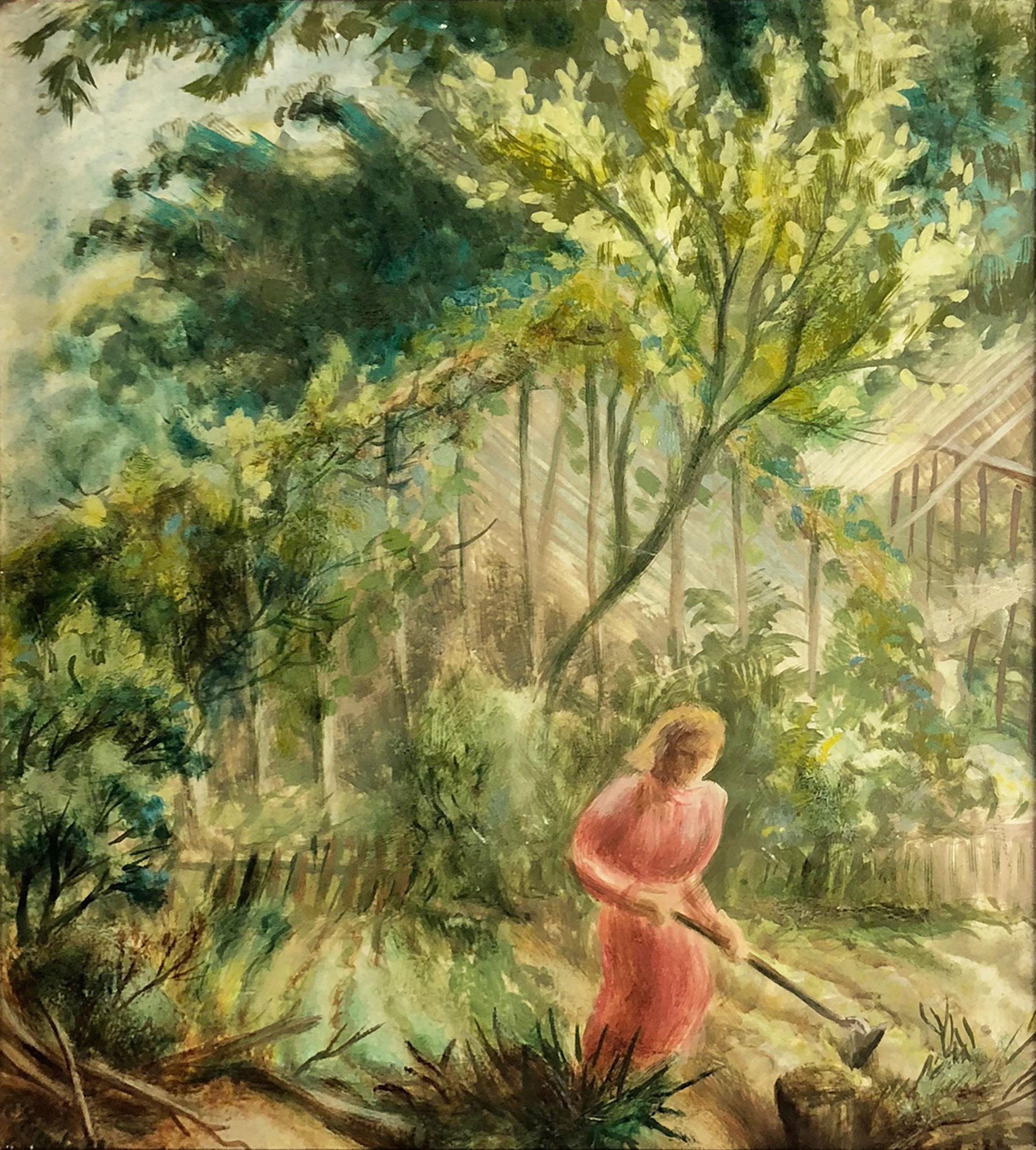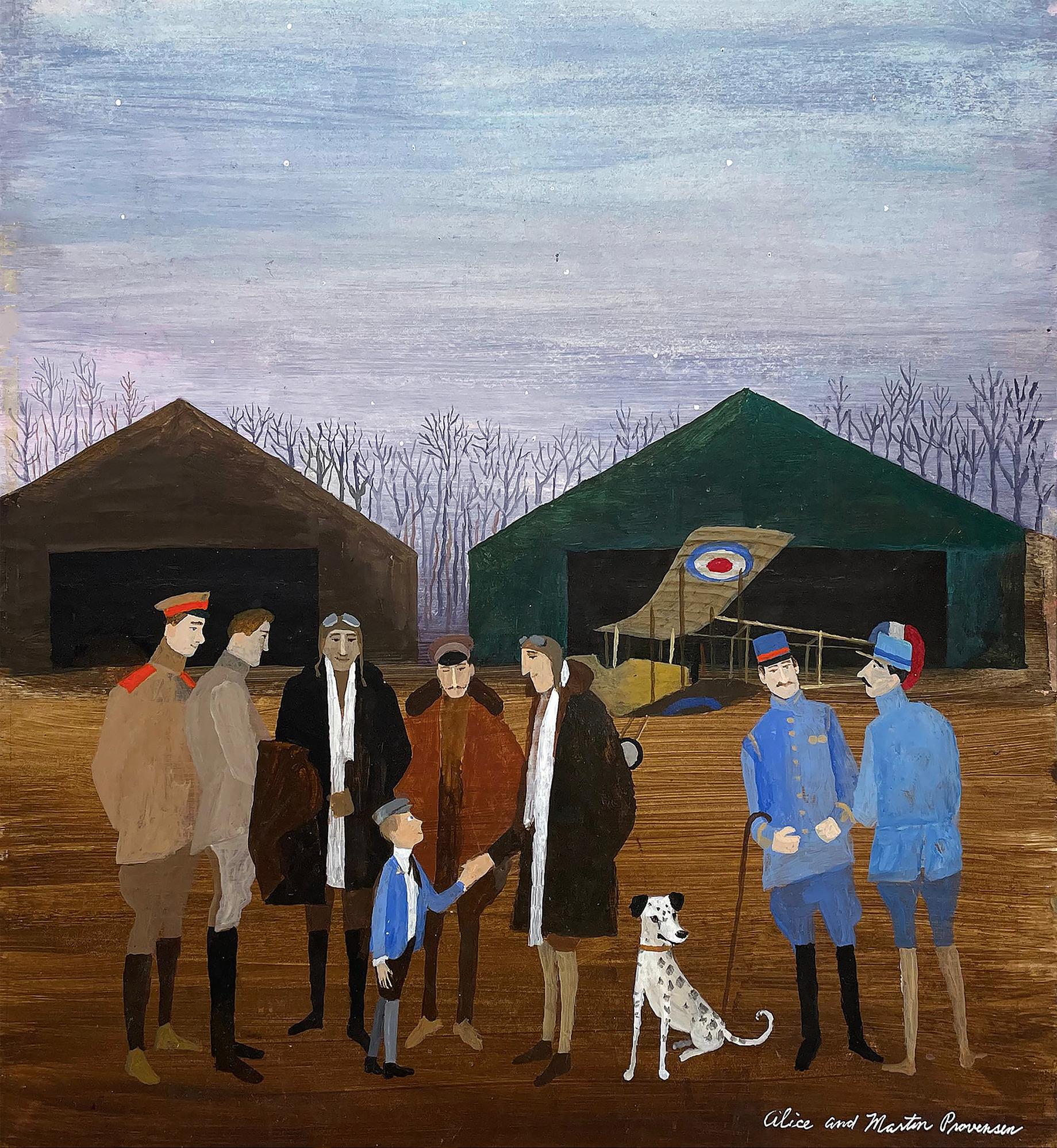Roger MedearisRabbit Hunters 1947
1947
About the Item
- Creator:Roger Medearis (1920 - 2001, American)
- Creation Year:1947
- Dimensions:Height: 9 in (22.86 cm)Width: 12 in (30.48 cm)Depth: 3 in (7.62 cm)
- More Editions & Sizes:9 x 12 inchesPrice: $35,000
- Medium:
- Movement & Style:
- Period:
- Condition:
- Gallery Location:Los Angeles, CA
- Reference Number:1stDibs: LU1859211388962
Roger Medearis
Though he came of age after Regionalism’s heyday in the 1930s, Roger Medearis is a direct connection to the Regionalism of Thomas Hart Benton. Born in Fayette, Missouri, Medearis went to Kansas City at the age of eighteen to study at the Kansas City Art Institute, with the hopes of becoming a commercial illustrator in the manner of Norman Rockwell. Shortly after his arrival, Medearis learned that Benton was an instructor at the Institute, and he soon was a regular in Benton’s classroom. In very short order, Meadearis absorbed every tenet of Benton’s pedagogical exhortations to study the masters of the Renaissance, with particular emphasis on formulating a strong overall design using repeated formal patterns as a structural principle for each painting. Meadearis also absorbed many of Benton’s own techniques as well, producing multi-figure Regionalist works in tempera and oil akin to the works of his master.
Medearis’s ascent in the art world was swift. After two years of schooling under Benton, in the summer of 1940, at the age of twenty, Medearis attempted his first major painting, Breaking Ground at Bethel (formerly in the collection of Himan Brown, New York), a genre painting featuring over twenty figures that depicted the groundbreaking of a country church. Benton was so impressed with this painting that he quickly had it added to an upcoming exhibition of the work of his more senior students to be held at the venerable Associated American Artists gallery in New York. What followed was a decade-long period of activity and sales in the New York art world, and the beginning of a lifelong friendship with Benton. (Medearis later penned a short and charming memoir of his relationship with Benton; see Roger Medearis, “Student of Thomas Hart Benton,” Smithsonian Studies in American Art 4 [Summer–Autumn 1990], pp. 47–61.)
Now under Benton’s wing, Medearis painted a number of striking Regionalist paintings, oftentimes using Benton’s studio. With Benton’s art world connections, Medearis found easy entry into New York galleries (Associated American Artists before World War II, Kende Galleries afterward), where he enjoyed a growing reputation as a notable exponent of Regionalism. When Benton was fired by the Kansas City Art Institute in the spring of 1941 for impertinent remarks about museum administrations, he and Medearis continued to enjoy a happy master-student relationship, with Medearis regularly bringing his paintings to Benton for critiques. After the outbreak of World War II, Medearis left Kansas City for New York in 1942, but he remained close with Benton, the two men keeping in close correspondence and visiting each other regularly. By 1950, however, with abstraction achieving a dominant position in the contemporary art world, Medearis decided to leave behind his career as an artist, and instead became a salesman for Container Corporation of America. Though he was successful in the business world, at Benton’s behest Medearis eventually returned to painting in 1966, though without the same vigor or incisive perception of Midwestern life as he had in his youth.
The subject of Saying Grace, a humorous work that dates from the artist’s student days in Kansas City, is very much in line with the oftentimes cheeky humor of Regionalist painters, who gently send up the lifestyles of their Midwestern subjects for consumption among New York collectors. A review of a 1949 exhibition of Medearis’s work at Kende Galleries, New York, aptly sums up his art:
In condensed form, the prankish scenes of Roger Medearis, on view at the Kende Galleries, are reminiscent of Bruegel, Koerner, and his teacher Thomas Hart Benton. His egg tempera travesties are peopled with good and bad mannered creatures in the best natured sense. They wallow in imagined luxuries or sit straight-jacketed in newly-wedded blisslessness. There seems no end to paintable ideas, no dearth of amusement or lack of straight-forward characterization. Landscapes, houses, folks and animals are all alive in a jolly and luminous world (“Condensed Americana,” The Art Digest 23, April 15, 1949).
Saying Grace is an iconic work by one of Regionalism’s most interesting artists, who until recently was little known because his best works were in private hands. Now that works like this one are coming back into circulation, Roger Medearis’s reputation will likely return to the level he had achieved in the 1940s.
(Biography provided by Hirschl & Adler)
- ShippingRetrieving quote...Ships From: Los Angeles, CA
- Return PolicyA return for this item may be initiated within 3 days of delivery.
- Subway ConstructionLocated in Los Angeles, CAThis painting is part of our exhibition American Coast to Coast: Artists of the 1930s Subway Construction, c. 1928, oil on board, 19 x 15 ¾ inches, signed upper left, artist and title verso; exhibited: 1) 12th Annual Exhibition of the Society of Independent Artists, The Waldorf Astoria, New York NY, from March 9 to April 1, 1928, no. 864 (original price $250) (see Death Prevailing Theme of Artists in Weird Exhibits, The Gazette (Montreal, Quebec, Canada), March 8, 1928); 2) Boston Tercentenary Exhibition Fine Arts and Crafts Exhibition, Horticultural Hall, Boston MA, July, 1930, no. 108 (honorable mention - noted verso); 3) 38th Annual Exhibition of American Art, Cincinnati Art Museum, Cincinnati, OH, June, 1931 (see Alexander, Mary, The Week in Art Circles, The Cincinnati Enquirer, June 7, 1931); and 4) National Art Week Exhibition [Group Show], Montross Gallery, New York, New York, December, 1940 (see Devree, Howard, Brief Comment on Some Recently Opened Exhibitions in the Galleries, The New York Times, December 1, 1940) About the Painting Ernest Stock’s Subway Construction depicts the excavation of New York’s 8th Avenue line, which was the first completed section of the city-operated Independent Subway System (IND). The groundbreaking ceremony was in 1925, but the line did not open until 1932, placing Stock’s painting in the middle of the construction effort. The 8th Avenue line was primarily constructed using the “cut and cover” method in which the streets above the line were dug up, infrastructure was built from the surface level down, the resulting holes were filled, and the streets reconstructed. While many artists of the 1920s were fascinated with the upward thrust of New York’s exploding skyline as architects and developers sought to erect ever higher buildings, Stock turned his attention to the engineering marvels which were taking place below ground. In Subway Construction, Stock depicts workers removing the earth beneath the street and building scaffolding and other support structures to allow concrete to be poured. Light and shadow fall across the x-shaped grid pattern formed by the wooden beams and planks. It is no surprise that critics reviewing the painting commented on Stock’s use of an “interesting pattern” to form a painting that is “clever and well designed.” About the Artist Ernest Richard Stock was an award-winning painter, print maker, muralist, and commercial artist. He was born in Bristol, England and was educated at the prestigious Bristol Grammar School. During World War I, Stock joined the British Royal Air Flying Corps in Canada and served in France as a pilot where he was wounded. After the war, he immigrated to the United States and joined the firm of Mack, Jenny, and Tyler, where he further honed his architectural and decorative painting skills. During the 1920s, Stock often traveled back and forth between the US and Europe. He was twice married, including to the American author, Katherine Anne Porter. Starting in the mid-1920s, Stock began to exhibit his artwork professionally, including at London’s Beaux Arts Gallery, the Society of Independent Artists, the Salons of America, the Cincinnati Art Museum, the Whitney Studio and various locations in the Northeast. Critics often praised the strong design sensibility in Stock’s paintings. Stock was a commercial illustrator for a handful of published books and during World War II, he worked in the Stratford Connecticut...Category
1920s American Modern Figurative Paintings
MaterialsOil
- Gold Mine, Central City, ColoradoBy Joseph MeertLocated in Los Angeles, CAThis painting is part of our exhibition America Coast to Coast: Artists of the 1930s Goldmine, Central City, Colorado, oil on canvas, 36 x 28 inches, c. 1936, signed lower right, ex collection of Platt Fine Art, Chicago, Illinois (label verso). About the Painting Joseph Meert’s painting, Goldmine, Central City, Colorado, depicts the short-lived resurrection of a once prominent city just outside Denver. Central City was founded in 1859 soon after John Gregory struck gold in the area. As word spread, thousands of miners converged into “Gregory’s Gulch” and its surroundings became known as the “richest square mile on earth.” Mining production quickly increased resulting in Central City to becoming Colorado’s largest city in the early 1860s. Despite some technical difficulties transitioning to lode mining and the rise of competition from Leadville, Central City remained an economic boom town through the turn of the century. But, with every boom, there is a bust. World War I marked the end of Central City’s prominence as ore production ground to a halt and by 1925, the town’s population shrank to only 400 people. The desperation of the Great Depression and a nearly 100% increase in the price of gold lured labor and capital back to Central City. Meert painted in Colorado during the mid-1930s, a time when he created his most desirable works. It is during this period of renaissance that Meert captures one of Central City's outlying dirt streets bordered by 19th century wooden houses from the town's heyday and the more recently installed electric lines leading to a distant gold mine. A lone figure trudges up the hill, a mother with a baby in her arms, putting us in mind of the rebirth of the town itself. Meert had solo exhibitions at the Colorado Springs Fine Arts Center in 1936 and the Denver Art Museum. Although it is not known whether Goldmine, Central City was included in either of these exhibitions, it seems likely. Moreover, the painting is closely related to Meert’s painting, The Old Road, which was painted in 1936 and exhibited at the Corcoran Gallery of Art in Washington, DC and at the Dallas Museum of Art. About the Artist Joseph Meert was a well-regarded painter and muralist, who initially made a name for himself in the American Scene and later as an abstract expressionist. Although initially successful, Meert struggled financially and with mental illness later in life. He was born in Brussels, Belgium, but moved with his family to Kansas City, Missouri. As a child, a chance encounter at the Union Pacific Railyard changed his life. Meert happened upon a worker repainting and stenciling a design on a railroad car. Meert later recalled that this experience introduced him to the idea of being a painter. Without support from his father, Meert obtained a working scholarship to the Kansas City Art Institute. After four years at the Kansas City Art Institute, Meert studied seven years at the Art Students League and in Europe and Los Angeles. At the Art Students League, Meert fell under the spell of Thomas Hart Benton and Stanton MacDonald-Wright. In 1931, he befriended Jackson Pollock. By 1934, Meert was part of the Public Works of Art Project when he met his wife, Margaret Mullin...Category
1930s American Modern Landscape Paintings
MaterialsCanvas, Oil
- Six O'ClockLocated in Los Angeles, CASix O-Clock, c. 1942, oil on canvas, 30 x 20 inches, signed and titled several times verso of frame and stretcher (perhaps by another hand), marked “Rehn” several times on frame (for the Frank K. M. Rehn Galleries in New York City, who represented Craig at the time); Exhibited: 1) 18th Biennial Exhibition of Contemporary American Oil Paintings from March 21 to May 2, 1943 at The Corcoran Gallery of Art in Washington, D.C. #87, original price $450 (per catalog) (exhibition label verso), 2) Craig’s one-man show at the Frank K. M. Rehn Galleries, New York City, from October 26 to November 14, 1942, #10 (original price listed as $350); and 3) Exhibition of thirty paintings sponsored by the Harrisburg Art Association at the State Museum of Pennsylvania in Harrisburg in March, 1944 (concerning this exhibit, Penelope Redd of The Evening News (Harrisburg, Pennsylvania) wrote: “Other paintings that have overtones of superrealism inherent in the subjects include Tom Craig’s California nocturne, ‘Six O’Clock,’ two figures moving through the twilight . . . .” March 6, 1944, p. 13); another label verso from The Museum of Art of Toledo (Ohio): original frame: Provenance includes George Stern Gallery, Los Angeles, CA About the Painting Long before Chris Burden’s iconic installation outside of the Los Angeles County Museum of Art, Urban Light, another artist, Tom Craig, made Southern California streetlights the subject of one of his early 1940s paintings. Consisting of dozens of recycled streetlights from the 1920s and 1930s forming a classical colonnade at the museum’s entrance, Burden’s Urban Light has become a symbol of Los Angeles. For Burden, the streetlights represent what constitutes an advanced society, something “safe after dark and beautiful to behold.” It seems that Craig is playing on the same theme in Six O-Clock. Although we see two hunched figures trudging along the sidewalk at the end of a long day, the real stars of this painting are the streetlights which brighten the twilight and silhouette another iconic symbol of Los Angeles, the palm trees in the distance. Mountains in the background and the distant view of a suburban neighborhood join the streetlights and palm trees as classic subject matter for a California Scene painting, but Craig gives us a twist by depicting the scene not as a sun-drenched natural expanse. Rather, Craig uses thin layers of oil paint, mimicking the watercolor technique for which he is most famous, to show us the twinkling beauty of manmade light and the safety it affords. Although Southern California is a land of natural wonders, the interventions of humanity are already everywhere in Los Angeles and as one critic noted, the resulting painting has an air of “superrealism.” About the Artist Thomas Theodore Craig was a well-known fixture in the Southern California art scene. He was born in Upland California. Craig graduated with a degree in botany from Pomona College and studied painting at Pamona and the Chouinard Art School with Stanton MacDonald-Wright and Barse Miller among others. He became close friends with fellow artist Milford Zornes...Category
1940s American Modern Landscape Paintings
MaterialsCanvas, Oil
- Industry and CommerceLocated in Los Angeles, CAThis mural study is part of our exhibition America Coast to Coast: Artists of the 1930s Industry and Commerce, 1936, tempera on panel, 16 ½ x 39 ½ inches, signed verso “John Ballat...Category
1930s American Realist Figurative Paintings
MaterialsTempera
- Knight’s LodgingLocated in Los Angeles, CAThis painting is part of our exhibition American Coast to Coast: Artists of the 1930s Knight’s Lodging, 1941, oil on canvas panel, signed and dated lower left, 16 x 20 inches, exhi...Category
1940s American Realist Figurative Paintings
MaterialsOil
- Factory WorkerLocated in Los Angeles, CAThis painting is part of our exhibition America Coast to Coast: Artists of the 1930s Factory Worker, c. 1936, oil on canvas, signed lower right, 18 ¼ x 36 inches; exhibited in City ...Category
1930s American Realist Figurative Paintings
MaterialsOil
- The Lonely Road by William Charles PalmerLocated in Hudson, NYThe Lonely Road (1940) Tempera on panel 12" x 16" 19 1/2" x 23 1/2" x 1 1/2" framed Hand-signed "Palmer '40" lower center. Provenance: Midtown Galleries, New York, NY (labels verso...Category
Mid-20th Century American Modern Figurative Paintings
MaterialsPanel, Tempera
- The Blue TopBy Robert VickreyLocated in Boston, MASigned verso: "Robert Vickrey". Titled verso: "The Blue Top". In fine condition.Category
Mid-20th Century American Modern Figurative Paintings
MaterialsCasein
- Tending the GardenBy Robert Elton TindallLocated in Missouri, MORobert Elton Tindall (1913-1983) "Tending the Garden" (Girl with a Hoe) c. 1940 Egg Tempera with Resin Oil Glazes on Panel Signed Lower Left Site: 10 x 9 inches Framed: 15 x 14 inch...Category
Mid-20th Century American Modern Figurative Paintings
MaterialsEgg Tempera, Wood Panel
- A Pair of Modern Impressionist Landscape Oil Paintings Framed Female artist NYLocated in Buffalo, NYA Pair of Modernist Landscapes by listed female artist Margaret Munro Stratton McLennan. Margaret was a painter working in the early 20th Century in the Syracuse area. These charmi...Category
1920s American Modern Landscape Paintings
MaterialsOil, Board
- Original Antique American Landscape Fishing Delaware River Oil Painting FramedLocated in Buffalo, NYA lovely scene adeptly painted by listed American artist and illustrator Jan Nosek (1876 - 1966) who was active in the late 19th and early 20th Century. This scene created in the ea...Category
1910s American Modern Landscape Paintings
MaterialsOil, Board
- "The Glorious Flight - Across the Channel with Louis Bleriot" - Children's BookBy Alice and Martin ProvensenLocated in Miami, FLStudy for "The Glorious Flight - Across the Channel with Louis Bleriot"; 1983; Gouache on Illustration Board; 14.5" x 13.75"; Signed Lower Right; Unframed. From Wikipedia, the free encyclopedia Alice Rose[1] Provensen (née Twitchell; August 14, 1918[2] – April 23, 2018[3]) and Martin Provensen...Category
1980s American Modern Figurative Paintings
MaterialsBoard, Gouache




